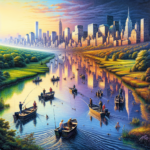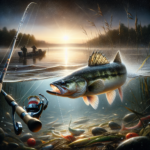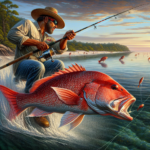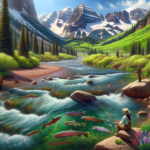Fishing in the Hudson River: New York City to Upstate

Introduction
Did you know that the Hudson River, stretching over 315 miles from the Adirondack Mountains to New York Harbor, is home to more than 200 species of fish? This diverse ecosystem offers a unique fishing experience, whether you’re casting a line in the bustling waters of New York City or the serene streams of Upstate New York.
In this article, we will explore the ins and outs of fishing in the Hudson River, covering everything from the best fishing techniques and species information to top fishing spots and seasonal considerations. Whether you’re a seasoned angler or a beginner, this guide will provide you with the knowledge and tips you need to make the most of your fishing adventure on the Hudson River.
Understanding the intricacies of fishing in the Hudson River is crucial for several reasons. Not only does it help you find the best spots and times to fish, but it also ensures that you are following local regulations and practicing sustainable fishing methods. This article aims to equip you with all the necessary information to have a successful and enjoyable fishing experience.
Background/Context
Historical or Cultural Significance
The Hudson River has a rich history that dates back to the early Native American tribes who relied on its waters for sustenance. European settlers later recognized its strategic importance, leading to the establishment of numerous towns and cities along its banks. The river has played a significant role in the economic and cultural development of New York State, making it a vital waterway for commerce, transportation, and recreation.
Geographical Overview
The Hudson River flows from the Adirondack Mountains in Upstate New York to the Atlantic Ocean at New York Harbor. The river’s ecosystem is diverse, featuring freshwater in its upper reaches and brackish water as it approaches the ocean. The climate varies along the river, with colder temperatures and more snowfall in the north and milder conditions in the south. This geographical diversity contributes to the wide range of fish species found in the Hudson River.
Key Points/Details
Fishing Techniques
Technique Overview
Several fishing techniques are effective in the Hudson River, including fly fishing, baitcasting, and trolling. Fly fishing is particularly popular in the upper reaches of the river, where trout and bass are abundant. Baitcasting and trolling are more commonly used in the lower sections, where larger species like striped bass and catfish can be found.
When and Where to Use
Fly fishing is best suited for the upper Hudson River during the spring and fall when trout are most active. Baitcasting and trolling are effective year-round but are particularly productive in the lower river during the summer months when striped bass migrate upstream.
Recommended Gear
- Fly Fishing: 5-7 weight rods, floating or sinking lines, and a variety of dry flies, nymphs, and streamers.
- Baitcasting: Medium to heavy rods, baitcasting reels, and lures such as crankbaits, spinnerbaits, and soft plastics.
- Trolling: Heavy rods, conventional reels, and trolling lures like spoons and deep-diving crankbaits.
Species Information
Species Overview
The Hudson River is home to a diverse array of fish species, including striped bass, largemouth bass, smallmouth bass, catfish, trout, and shad. Each species has its own unique habits and preferred habitats, making the river a versatile fishing destination.
Best Practices
- Striped Bass: Use live bait such as herring or artificial lures like swimbaits and jigs. Fish near structures like bridges and piers during the spring and fall migrations.
- Largemouth Bass: Target shallow areas with vegetation using topwater lures, spinnerbaits, and soft plastics. Early morning and late evening are the best times to fish.
- Trout: Fly fishing with dry flies, nymphs, and streamers is effective in the upper river. Focus on riffles, pools, and undercut banks during the spring and fall.
Location Information
Top Fishing Spots
- New York City: Pier 84, Inwood Hill Park, and the Harlem River are popular spots for striped bass and catfish.
- Mid-Hudson Valley: Esopus Creek, Rondout Creek, and the Catskill Creek offer excellent trout and bass fishing opportunities.
- Upstate New York: The upper Hudson River near Glens Falls and the tributaries in the Adirondacks are prime locations for trout and smallmouth bass.
Regulations and Licenses
Fishing in the Hudson River requires a valid New York State fishing license. Regulations vary by species and location, so it’s essential to check the New York State Department of Environmental Conservation (DEC) website for the latest rules and catch limits. Some areas may have specific seasonal restrictions or require special permits.
Seasonal Considerations
Seasonal Variations
Fishing conditions in the Hudson River change throughout the year. Spring and fall are prime times for trout and striped bass, while summer is ideal for bass and catfish. Winter fishing can be challenging due to cold temperatures and ice, but hardy anglers can still find success targeting species like walleye and perch.
Best Times to Fish
- Spring: March to May for trout and striped bass.
- Summer: June to August for largemouth bass, smallmouth bass, and catfish.
- Fall: September to November for trout and striped bass.
- Winter: December to February for walleye and perch.
Events and Tournaments
Event Overview
The Hudson River hosts several fishing events and tournaments throughout the year, including the Hudson River Striper Derby and the Catskill Fly Fishing Center’s annual Trout Parade. These events offer opportunities for anglers to compete, learn new techniques, and connect with the fishing community.
Preparation Tips
- Register early to secure your spot in popular tournaments.
- Practice your casting and retrieval techniques to improve your chances of success.
- Ensure your gear is in top condition and bring backup equipment in case of malfunctions.
Tips and Best Practices
General Tips
- Always check the weather forecast before heading out to ensure safe and comfortable fishing conditions.
- Keep a fishing journal to track your catches, techniques, and conditions for future reference.
- Respect other anglers and practice good fishing etiquette by giving others plenty of space and keeping noise to a minimum.
Avoid Common Mistakes
- Not checking local regulations: Always verify the latest rules and catch limits to avoid fines and penalties.
- Using the wrong gear: Ensure you have the appropriate equipment for the species and techniques you plan to use.
- Ignoring seasonal patterns: Adjust your fishing strategies based on the time of year and the behavior of your target species.
Advanced Techniques
- Drift Fishing: Use the river’s current to your advantage by drifting bait or lures downstream to cover more water and increase your chances of a bite.
- Electronics: Utilize fish finders and GPS devices to locate fish and navigate the river more effectively.
- Match the Hatch: Pay attention to local insect hatches and use flies or lures that mimic the natural prey of your target species.
Gear and Equipment Recommendations
Essential Gear
- Fishing rod and reel appropriate for your target species and techniques.
- Fishing line, leaders, and tippets suitable for the conditions and species.
- A variety of lures, flies, and bait to match the preferences of different fish.
- Fishing license and any required permits.
- Safety gear, including a life jacket, first aid kit, and sunscreen.
Optional Gear/Upgrades
- Polarized sunglasses to reduce glare and improve visibility.
- Waders and wading boots for fishing in shallow water.
- Fishing vest or tackle bag to keep your gear organized and easily accessible.
- Fish finder or GPS device for locating fish and navigating the river.
Where to Buy or Rent
Local bait and tackle shops along the Hudson River offer a wide range of fishing gear and equipment. Some popular options include River Basin Sports in Catskill, Kenco Outfitters in Kingston, and Orvis in Manhattan. Online retailers like Bass Pro Shops, Cabela’s, and Amazon also provide a vast selection of fishing gear.
Safety and Conservation
Safety Tips
- Always wear a life jacket when fishing from a boat or near deep water.
- Be aware of weather conditions and avoid fishing during storms or high winds.
- Stay hydrated and protect yourself from the sun with sunscreen, hats, and long sleeves.
- Inform someone of your fishing plans and expected return time.
Conservation Practices
- Practice catch and release to help maintain healthy fish populations.
- Follow local regulations and catch limits to ensure sustainable fishing practices.
- Dispose of fishing line, hooks, and other waste properly to protect wildlife and the environment.
- Respect the natural habitat by avoiding damage to vegetation and minimizing your impact on the ecosystem.
Planning Your Trip
Accommodations
There are numerous lodging options along the Hudson River, ranging from hotels and motels to campgrounds and vacation rentals. Some popular choices include the Thayer Hotel at West Point, the Beekman Arms in Rhinebeck, and the North-South Lake Campground in the Catskills.
Travel Tips
- Plan your route in advance and consider traffic conditions, especially when traveling through New York City.
- Check for any road closures or construction that may affect your travel plans.
- Consider using public transportation or ride-sharing services if parking is limited at your fishing destination.
Additional Activities
The Hudson River Valley offers a variety of activities for non-fishing time, including hiking, kayaking, and visiting historical sites. Popular attractions include the Walkway Over the Hudson, the Vanderbilt Mansion, and the Storm King Art Center.
Frequently Asked Questions (FAQs)
Do I need a fishing license to fish in the Hudson River?
Yes, a valid New York State fishing license is required to fish in the Hudson River. You can purchase a license online through the New York State Department of Environmental Conservation (DEC) website or at local bait and tackle shops.
What are the best times of year to fish in the Hudson River?
The best times to fish in the Hudson River vary by species. Spring and fall are ideal for trout and striped bass, while summer is great for bass and catfish. Winter fishing can be challenging but rewarding for species like walleye and perch.
What types of fish can I catch in the Hudson River?
The Hudson River is home to a diverse array of fish species, including striped bass, largemouth bass, smallmouth bass, catfish, trout, shad, walleye, and perch.
Are there any fishing tournaments on the Hudson River?
Yes, the Hudson River hosts several fishing tournaments throughout the year, including the Hudson River Striper Derby and the Catskill Fly Fishing Center’s annual Trout Parade. These events offer opportunities for anglers to compete and connect with the fishing community.
Conclusion
Fishing in the Hudson River offers a unique and rewarding experience for anglers of all skill levels. From the bustling waters of New York City to the serene streams of Upstate New York, the river provides diverse fishing opportunities and a rich array of fish species. By understanding the best techniques, gear, and locations, as well as following local regulations and practicing sustainable fishing methods, you can make the most of your time on the Hudson River.
Whether you’re targeting striped bass in the lower river or fly fishing for trout in the upper reaches, this guide has provided you with the knowledge and tips you need for a successful fishing adventure. So grab your gear, head to the Hudson River, and enjoy the thrill of fishing in one of New York’s most iconic waterways.




